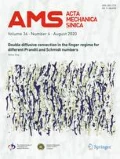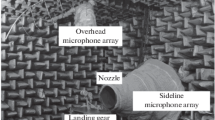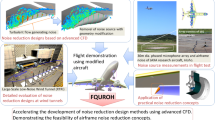Abstract
Landing gears of commercial aircraft make an important contribution to total aircraft noise in the approach configuration. Using fairings to shield components from high speed impingement reduces noise. Furthermore, perforating these fairings has been confirmed by flight tests to further enable noise reduction. Following an earlier fundamental study of the application of perforated fairings, a study has been performed to investigate and optimize the benefits of bleeding air through landing gear fairings. By means of wind tunnel tests, an aerodynamic and acoustic survey has been performed on a simplified generic main landing gear to explore the influence of (perforated) fairings on the lower part of the gear. The results show that for this specific case, the application of impermeable fairings reduces noise in the mid- and high frequency range by shielding sharp edged components from high velocity impingement. However, below 1 kHz the noise is shown to increase significantly. Application of the perforations is shown to diminish this low frequency increase whilst maintaining the reduction in the mid- and high frequency range. The aerodynamic and acoustic measurements point in the direction of the separated flow of the fairings interacting with the downstream gear components responsible for the low frequency noise increase. Bleeding of the air through the fairings reduces the large scale turbulence in the proximity of these components and hence diminishes the low frequency noise increase.
Similar content being viewed by others
Abbreviations
- Cp :
-
Pressure coefficient
- f :
-
Frequency, Hz
- n :
-
Block size
- p :
-
Static pressure, Pa
- p ref :
-
Acoustic reference pressure, Pa
- Re :
-
Reynolds number
- St :
-
Strouhal number
- U :
-
Velocity, m/s
- u :
-
Velocity vector, m/s
- \({\varphi}\) :
-
Wheel polar angle, degrees
- ρ :
-
Air density, kg/m3
- ∞:
-
Freestream conditions
References
Dobrzynski, W., Buchholz, H.: Full-scale noise testing on Airbus landing gears in the German Dutch wind tunnel. AIAA Paper 97-1597 (1997)
Lopes, L., Brentner, K., Morris, P., Lilley, G., Lockard, D.: Complex landing gear noise prediction using a simple toolkit. AIAA Paper 2005-1202 (2005)
Dobrzynski, W., Chow, L., Guion, P., Shiells, D.: A European study on landing gear airframe noise sources. AIAA Paper 2000-1971 (2000)
Piet, J.F., Chow, L., Laporte, F., Remy, H.: Flight test investigation of high-lift devices and landing gear modifications to achieve airframe noise reduction. In: ECCOMAS 2004 Conference. Jyvaeskylae, Finland (2004)
Piet, J.F., Davy, R., Elias, G., Siller, H., Chow, L., Seror, C., Laporte, F.: Flight test investigation of add-on treatments to reduce aircraft airframe noise. AIAA Paper 2005-3007 (2005)
Smith, M., Fenech, B., Chow, L., Molin, N., Dobrzynski, W., Seror, C.: Control of noise sources on aircraft landing gear bogies. AIAA Paper 2006-2626 (2006)
Li, Y., Smith, M., Zhang, X., Molin, N.: Noise sources control of an aircraft landing gear. AIAA Paper 2007-3465 (2007)
Boorsma, K., Zhang, X., Molin, N.: Perforated farings for bluff body noise control. AIAA Paper 2007-3462 (2007)
Boorsma K., Zhang X., Molin N., Chow L.: Bluff body noise control using perforated farings. AIAA J. 47(1), 33–43 (2009)
Davies, P.: The new 7 by \({5 \frac{1}{2}\,{\rm ft}}\). and 15 by 12 ft. low speed wind tunnel at the University of Southampton. Tech. Rep. 202, A.A.S.U. (1961)
Smits A., Lim T.: Flow Visualization: Techniques and Examples. Imperial College Press, London (2000)
Merzkirch W.: Flow Visualization, 2nd edn. Academic Press, London (1987)
Dantec Dynamics A/S, Tonsbakken 18, DK-2740 Skovlunde, Denmark: FlowManager Software and Introduction to PIV Instrumentation (2002). Publication no. 9040U3625
Raffel M., Willert C., Kompenhans J.: Particle Image Velocimetry, A Practical Guide, corrected 3rd printing edn. Springer, Berlin (2000)
Moffat R.: Describing the uncertainties in experimental results. Exp. Thermal Fluid Sci. 1, 3–17 (1988)
Fenech, B., Takeda, K.: Sotonarray: Southampton university wind tunnel microphone array system guide. Tech. Rep. AFM 07/03, University of Southampton, School of Engineering Sciences (2007)
Humphreys, W. Jr., Brooks, T., Hunter, W. Jr., Meadows, K.: Design and use of microphone arrays for aeroacoustic measurements. AIAA Paper 98-0471 (1998)
Author information
Authors and Affiliations
Corresponding author
Rights and permissions
About this article
Cite this article
Boorsma, K., Zhang, X. & Molin, N. Landing gear noise control using perforated fairings. Acta Mech Sin 26, 159–174 (2010). https://doi.org/10.1007/s10409-009-0304-0
Received:
Revised:
Accepted:
Published:
Issue Date:
DOI: https://doi.org/10.1007/s10409-009-0304-0




